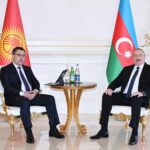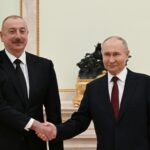DNA tests for genealogy and “ethnicity” have become very popular in recent years. I personally doubt that ethnicity can be determined by a DNA test, hence the quotation marks.
The fact is that the last mutation of haplogroups, which are used to determine ethnicity in these tests, stopped even before humans switched to a sedentary lifestyle, before languages and cultures were formed. People did not plow, sow, plant and wait for months for the harvest back then—they hunted and gathered, moving freely around the planet that had no borders. And they maintained communication with each other in those ancient times, before the emergence of language, simply by making various sounds. In other words, ethnicity those tests are now trying to estimate did not exist at that time and began to form much later.
Meanwhile, people’s interest in their ethnicity persists. But if we really need a parameter to define it, then we should start with language. I believe that language, and not physiology, skin color or eye shape, is the key factor that differentiates peoples and ethnic groups—not an acquired language, but the language one has heard since birth, the language in which one first spoke, in which one best expresses one’s thoughts and, most importantly, the language in which one thinks. Language performs a very important function, determining the direction of the stream of consciousness. When we speak, and especially when we think, one of the main factors that guide the flow of our thoughts is the meaning of words and the way we construct sentences. The mentality of a person who starts a sentence with a subject is somewhat different from that of someone who starts a sentence with a predicate. Similarly, a person who says “yoxlamaq“, focusing on denial (“yox“, meaning “no“), and a person who says “verify“, focusing on truth (from Latin “verus”, i.e., “true”), are people with different mental navigation.
Imagine a person whose both biological parents are Kenyans, but the person themselves was born in Germany and their native language is German. If we wake them up in the middle of the night, show them the H2O formula and ask what it is, and they say “Wasser”, then we have a real German, and there is no ground to classify them as any other nationality.
Thus, people whose native language is Azerbaijani can be classified as those thinking in Turkic, or, put simply, Turkic people: ancient Turks, people who were completely different from us, still live in our subconscious, and our way of thinking is determined by their mental formulas.
There is a linguistic hypothesis placing the Turkic languages in the same group with Mongolian and in the Altai language family. Some scholars also classify the Manchu, Korean and Japanese languages in this group, believing that they all originated from a single ancient language. But there are also researchers who support the theory that the Turkic languages belong to a separate, independent language family. If we assume that the stream of our consciousness is guided by the ancient Turks, then we should take a step back in history and learn more about these people and how their language turned into ours, despite the fact that we are so different from them in physical appearance. Bear in mind that, although the historical and cultural factors do not run as deep as the linguistic one, they nevertheless play an important role in determining ethnicity.
First of all, here are several very significant, albeit unpopular in our country, facts about the ancient Turks that I have learned in recent years. One of the most curious among them is that the ethnonym “Turk” was first mentioned in the 6th century CE, that is, this word is not as ancient as one might expect. Ironically, the name of the Kyrgyz, now considered a Turkic ethnic group, was known to the Chinese as far back as in the 2nd century. It turns out that the word “Turk” is even younger than the word “Kyrgyz“, which is now considered its subcategory. Those who would later be called Turks and Kyrgyz probably were originally part of the Huns. But then a significant portion of this people moved to the west and after a while dissolved in a vast territory from Central Asia to present-day France. In the 6th century a group branching off from that people appeared in the world arena under the name of Turks, creating a nomadic empire in the expanse between present-day Ukraine and China.
Another fact concerns the meaning of the word “Turk“. According to the orientalist Vasily Bartold, who made a significant contribution to Turkology, the word “Turk”/”Türk” comes from the word “törük” (or “türük”), which, in turn, comes from the word “Törə” (“law“) and, apparently, was used in the meaning of “legislation“, “legal“, “reasonable“. Perhaps, at some point in history, some strong tribe took this name for itself to prove that the territory they occupied rightfully belonged to them. That is, it declared: “we are here by right”, “we are here on legal grounds”, and the others, over time, also began to call them that. Or perhaps not one, but several tribes living in different territories called themselves that, and eventually all of them began to be called Turks.
***
As for the context of Turkism that concerns us directly, we must start with the fact that we are the Oghuz, a specific variety of Turkic peoples that substantially differs from all the others and has completely different racial characteristics compared to the ancient Turks.
The first mentions of the word “Oghuz” are found in phrases like “Üch-Oghuz” (“three Oghuz“) or “Tokuz-Oghuz” (“nine Oghuz“), which gives the researchers reason to believe that in the ancient Turkic language it simply meant “tribe”. I talked about this once with my friend, composer Turker Gasimzade, and he suggested that the word “Oghuz” could be a short form of the expression “oğul-qız” (“sons and daughters”). But, to be honest, none of the few books I have read on this subject offered this explanation, and if no Turkologist has put forward a similar version so far, then my friend’s observation can be considered quite a significant and plausible guess.
Thus, starting from the 9th or 10th centuries CE, this word, previously used only in the meaning of “tribe”, began to be used as an ethnic definition of a group of Turks living in Central Asia. From about the same period, this group was also called the Turkmens, and several centuries later the word “Turkmen” took over the word “Oghuz“.
The Oghuz/Turkmens are distinguished among other Turks as a separate sub-ethnos for a reason. Their anthropology contrasted sharply with the typical Turkic appearance. The Oghuz had neither a purely Mongoloid eye shape, nor wide protruding cheekbones. And there was an important reason for that: the Oghuz/Turkmens appeared as a result of the mixing of the Turks who came from the east with the Indo-European (Aryan or Iranian-speaking) peoples living in Central Asia—the population of Transoxania, Sogdiana and Margiana. The Oghuz looked like Indo-Europeans, and their language and culture resembled Turkic. Some scholars even found traces of Central Asian Indo-Europeans in the names of several Oghuz clans, for example, “Dugers“/”Tokhars“, etc.
The presence of Iranian-language intonations and rhythms in the Oghuz/Turkmen dialect is also cited as evidence that they are the result of the blending of these two peoples. Probably, it was then that the Divs came into our fairy tales, and we began to celebrate Novruz.
Outstanding scientist-encyclopedist Rashid al-Din Fazlullah (Hamadani), who was the vizier in the Hulaguid state (Ilkhanate), in his famous work Jami’ al-Tawarikh (Compendium of Chronicles, 1310), mentions that the Oghuz looked different from Turks. In his opinion, this was due to the climate of the places where they settled—present-day Turkmenistan and the shores of the Aral Sea. But just a few pages later, he retells a popular folk legend. They say that in the old days Turkmens reproached Tajiks for not thinking of them as related, and Tajiks answered, “You are no longer Tajiks, but Turkmanands (looking like Turks)”. In my opinion, this version is much more plausible and sheds light on many issues, including the etymology of the word “Turkmen”.
In view of the above, the theory put forward by some Iranian historians that the Azerbaijani Turks were a local Iranian people assimilated during the Mongol conquests can be considered erroneous. True, Iranian-speaking peoples are one of the important substrates of our ethnicity, just not those who live in modern Iran, but others, who lived in ancient times in Central Asia—not the Persians, but the Parthians; and it happened long before the Mongol conquests. As a matter of fact, before the advent of mass education systems, widespread assimilation was practically impossible. When communicating with representatives of the ruling class, people may have spoken their language, but it was impossible to keep track of what language everyone speak at home, in neighborhoods and villages. And nobody was going to keep track of that anyway. Until modern history, language and ethnicity did not have much importance—what mattered the most was religious or class affiliation.
Since we have already discussed Turks in general and the Oghuz/ Turkmens in particular, we can make the topic more specific and focus directly on us. Turkmens, Azerbaijanis and Turks are considered the three main modern descendants of the Oghuz.
Everything is clear with the Turkmens: they never left the borders of our common historical homeland, they named the lands that had once been called Margiana after themselves, and they still live there.
The main cultural predecessors of Turks are the Seljuks. It is assumed that it was the Seljuks who brought the Oghuz Turks to Asia Minor and laid the foundation for the existing Turkic culture there.
But, despite the fact that the Seljuks also passed through the territory where we live now and had a certain influence on these places, it is still very difficult to link our cultural tradition to them.
The roots of the cultural and political traditions of the Azerbaijani Turks (as well as the East Anatolian Turks and Iraqi Turkmens) surely go back to the Turkmens who came to these territories during the Mongol conquests and were directly involved in the establishment and fall of the Hulaguid state (Ilkhanate).
Here is one fact about the Mongol conquests, which, being undisputed by scholars, is nevertheless not very popular among the public: the Mongol hordes, in fact, consisted of numerous Turkic-speaking peoples under the command of a small Mongolian military elite. The numerical ratio of Turkic peoples and Mongols around the world at the time was probably about the same as it is now. If we look at the decline of the empire created by Genghis Khan and his heirs (the largest contiguous land empire in history), we will see that immediately after the disappearance of the Mongolian statehood, states of Turkic-speaking peoples began to emerge across the territory of the fallen empire—from Eastern Europe to China, from Siberia to Syria.
There is no doubt that Turkic-speaking peoples first set foot on these lands long before the Mongol invasions and even before the Seljuks—probably in the first centuries of the common era. But none of them, including the Seljuks, were able to consolidate their cultural and political traditions here and bring on serious ethnic and demographic changes.
After the Hulaguids, an almost continuous line can be traced: Chobanids—Qara Qoyunlu—Aq Qoyunlu—Safavids—Qajars—Khanates—Republic of Azerbaijan. Even after the Russian conquest in the 19th century, a small educated stratum of Azerbaijanis did not forget their history: in the book Karabakhname, the genealogy of the Karabakh khans is linked to the Mongol khan Hulagu and newcomers from Turkestan (!). Even at the beginning of the 20th century, the poet Ahmad Javad called the Azerbaijani flag “a child of Ilkhan”.
In the times of the Hulaguids rose the star of Tabriz, a key city in our ethnicity. Previously, Tabriz had been less important not only compared to Ardabil and Ganja, but even to Barda and Derbent. Hulaguid rulers made Tabriz their capital, turning it into one of the most important cities not only in the region, but, possibly, in the whole world. Thus, the making of Tabriz as a capital city dates back to that period. Tabriz is also one of the connecting links between all the aforementioned dynasties. For all of them, it was the capital for about four centuries, then the second most important city. These dynasties simply replaced one another, like political parties at the head of one country and one culture.
Of course, we underwent certain anthropological changes in other territories as well, including the territory of modern Iran, but it happened as naturally. As we know, the environment is of great importance for the life of a biological species: evolution chooses not only the strongest, but also the most suitable. And here the old man Rashid al-Din was partly right highlighting the role of climate in the Turkmens’ anthropological change. But these processes occur not exactly as he described—not because people simply breathe the air and drink the water of the places where they live. Nature chooses the most suitable individuals only among the subsequent generations.
Suppose some Turkmen who ended up in this region during the Mongol conquests marries a local girl. Suppose they have two children, each of whom looks like one of the parents. Each of these two children subsequently continues their line, having children of their own. Which of these two anthropological options will persist over the next centuries under the influence of the air, water and food of this location? Of course, Central Asian features will gradually fade from generation to generation. But those children and their descendants will consider themselves Turkmen, speak Turkmen, think Turkmen and remain bearers of Turkmen culture.
The Oghuz/Turkmens who participated in the Seljuk invasions also differed from their relatives who came here with the Mongols in their attitude to Islam. The former adopted Islam in Central Asia and the faraway Baghdad was of idealized importance in their eyes. This is why, having conquered the entire Middle East, they did not touch Baghdad, recognized the religious leadership of the Caliph and continued to wage their wars, now mainly with Christians. The other group, apparently, were still Tengrists who worshiped natural forces, were skeptical of Islam, and therefore willingly participated in the capture and destruction of Baghdad in 1258. Remember how important this event is in world history: until then Baghdad had been known as one of the centers of world science. Remember that one of the main reasons the Islamic world was plunged into darkness, in which it remains to this day, is that the population of this city was exterminated and enslaved in the course of one week.
Only half a century later, the Oghuz/Turkmens who participated in the Mongol conquests converted to Islam by order of the Hulaguid ruler Gazan Khan, that is, administratively. This must be why they never became adherents of Sunnism (an orthodox branch of Islam) and gravitated towards Sufism, which allowed them to adapt elements of Tengrism. Even the ruler of Aq Qoyunlu, Uzun Hasan, whom we know to be Sunni, considered it impossible to govern his Turkmen subjects according to Sharia law and had to write a special Qanunname (Code of Laws) in the Turkic language regulating legal issues among them. Considering all of the above, we can draw the border dividing the cultures of these two Oghuz “types” through the east of Anatolia—the western border first of the Hulaguid state, later Aq Qoyunlu, and, finally, from the first decade of the 16th century, the Safavid state. The Alevis living in eastern Anatolia still remember the events of the early 16th century. In their songs, they praise Shah Ismail and curse the Ottoman Sultan Selim, who had 40,000 Alevis executed in Anatolia. Most importantly, all this is passed via generational memory, and not via cinema, literature or some kind of modern analytics. None of the peoples living in the territories once ruled by the Safavids managed to preserve its adherence to the Qizilbash culture as the Alevis did, probably because around that time they found themselves within a Sunni state, and this situation intensified their cultural confrontation. They never thought of the Ottoman Sultan as their ruler and tried to preserve the memory of their shah.
On the other side of the border, however, things turned out completely differently. We were almost identical with the Alevis at that time, but at the behest of Shah Abbas I we accepted “true Islam”—Shia Islam in its present form.
Under Shah Abbas, the system that had existed until that time in the Safavid state and was, in fact, a confederation of Turkmen tribes, was abolished and replaced by a centralized system. But since this systemic change took place in Isfahan, the issues related to Sharia law were addressed to the local theologians and their opinion was taken into account. In contrast to the situation with the Anatolian Alevis, the change in doctrine here was carried out by our own shah, and did not meet with much opposition, resulting in the loss of many old traditions. We can try to imagine the atmosphere of that time…
A “commission” from Isfahan finds out that the Turkmens living in present-day central regions of Azerbaijan or in the city of Maragha in the south have a tradition of playing saz at funerals and regard it as blasphemy. “Excuse me, you can’t bury the dead to the sounds of saz, give up your Terekemen (“Terekemen” in Arabic means “Turkmen”) ways and become true Muslims already!” the commission says. Perhaps it was then that we began to forget our Turkmen identity and to identify ourselves as “Muslims”. Perhaps even the sheikhs and dervishes from the south in the works of Azerbaijani enlighteners are also an echo of the mentality that during the time of Shah Abbas urged us to send for someone from Isfahan to “explain this unfamiliar religion to us.”
Going back to the beginning of our conversation, let’s sum up: don’t believe the articles on Internet saying that “it turns out that there are only 4% of ‘genetic Turks’ living in Turkey,” or that “at the genetic level, Armenians are Hindus”.
If a person thinks in Armenian and considers themselves an Armenian, then, whether they are fair-skinned or dark-skinned, or looking like a Japanese, it would be most appropriate to consider them an Armenian.
If we perceive national identity not as a biological, but as a sociological phenomenon, then we can say that the origins of our national identity are the Oghuz, who were a hybrid of Turkic and Iranian-speaking peoples. Or, one might say, Indo-Europeans who think in Turkic.
Aze.Media
If you want to contribute and have specific expertise, please contact us at [email protected]










